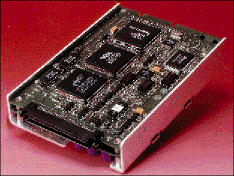Thin-server module
simplifies network design
The Plug & Stor 100SA, from Creative Design Solutions (Santa Clara, CA), is a thin-server module for integration into storage subsystems to enable the subsystems to become network attached storage (NAS) units. The modules attach to networks via a 10- or 100-Mbit/s Ethernet RJ-45 connection. Thin servers allow data to be stored at various locations in a network, thereby eliminating information bottlenecks that occur with a central server.
The thin-server approach to data storage is indicative of future trends in network management. According to Michael Peterson, president of Strategic Research (Santa Barbara, CA), “The emerging NAS market is poised for significant growth and is estimated to be $4.5 billion by the year 2000.” It is also an alternative to creating an individual network with a proprietary operating platform as in the thin-vs.- fat-client issue (see Electronic Products , Nov. 1997, p. 27).

Offered as the industry's smallest thin server, the 100SA
has a self-repairing file system and automatically sends
e-mail messages that report on system status.
The model 100SA is offered as the smallest thin server in the industry, measuring 1 (H) x 4 (W) x 5.75 (D) in., which allows it to be mounted in half- or full-height drive bays. Modules can be installed anywhere in the network and require no license fees.
In addition, the module is also the first thin server to use a self-repairing file system and automatically send e-mail messages reporting on system status. Related software is stored in nonvolatile memory and includes a real-time operating system (called embedded server architecture, ESA), RAID 1 software, and the company's EZ-Serv menu-driven interface.
ESA uses a self-repairing file system, known as journaling, that logs path names to reduce the chance of data loss. It also eliminates the need for a monitor, keyboard, and mouse by allowing the server to be set up and managed through a standard browser from any computer on the network.
The EZ-Serv program can be configured to automatically send e-mail messages that report problems and system status. RAID software is employed to allow data to be mirrored.
A Pentium processor socket is provided within which a 133-, 166-, or 200-MHz Pentium can be installed. Network connection is via an RJ-45 Ethernet cable with transfer speed automatically set to 10 or 100 Mbits/s.
The 100SA provides one small-outline DIMM socket and one Ultra-Wide SCSI port that supports up to 14 devices. Network protocols supported include TCP/IP, SMB, and HTTP. The device is Plug and Play, Windows 3.1.1/95/NT, OS/2, DOS, NetPC, and NC compatible.
Full production of the 100SA will begin this month and it will be available during this quarter. The module comes with or without a processor and a single unit with a 133-MHz Pentium will cost $990. For further information, contact Creative Design Solutions at 408-653-1330, fax 408-653-1331, visit http://www.creative design.com .
–Mathew A. Dirjish
Advertisement





